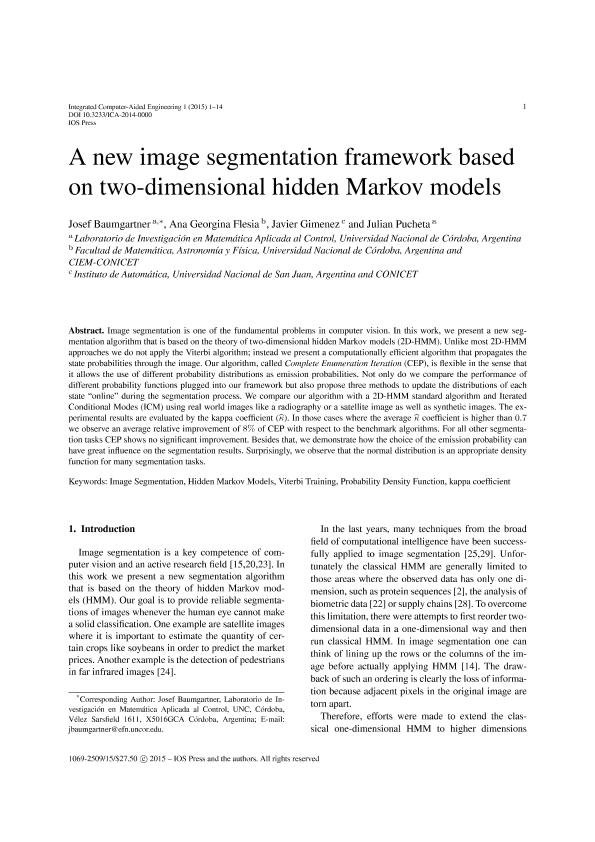Mostrar el registro sencillo del ítem
dc.contributor.author
Baumgartner, Josef Sylvester

dc.contributor.author
Flesia, Ana Georgina

dc.contributor.author
Gimenez Romero, Javier Alejandro

dc.contributor.author
Pucheta, Julián Antonio

dc.date.available
2018-09-05T15:33:41Z
dc.date.issued
2015-12
dc.identifier.citation
Baumgartner, Josef Sylvester; Flesia, Ana Georgina; Gimenez Romero, Javier Alejandro; Pucheta, Julián Antonio; A new image segmentation framework based on two-dimensional hidden Markov models; IOS Press; Integrated Computer-aided Engineering; 23; 1; 12-2015; 1-13
dc.identifier.issn
1069-2509
dc.identifier.uri
http://hdl.handle.net/11336/58360
dc.description.abstract
Image segmentation is one of the fundamental problems in computer vision. In this work, we present a new segmentation algorithm that is based on the theory of two-dimensional hidden Markov models (2D-HMM). Unlike most 2D-HMM approaches we do not apply the Viterbi algorithm; instead we present a computationally efficient algorithm that propagates the state probabilities through the image. Our algorithm, called Complete Enumeration Iteration (CEP), is flexible in the sense that it allows the use of different probability distributions as emibion probabilities. Not only do we compare the performance of different probability functions plugged into our framework but also propose three methods to update the distributions of each state "online" during the segmentation proceb. We compare our algorithm with a 2D-HMM standard algorithm and Iterated Conditional Modes (ICM) using real world images like a radiography or a satellite image as well as synthetic images. The experimental results are evaluated by the kappa coefficient (κ). In those cases where the average κ coefficient is higher than 0.7 we observe an average relative improvement of 8% of CEP with respect to the benchmark algorithms. For all other segmentation tasks CEP shows no significant improvement. Besides that, we demonstrate how the choice of the emibion probability can have great influence on the segmentation results. Surprisingly, we observe that the normal distribution is an appropriate density function for many segmentation tasks.
dc.format
application/pdf
dc.language.iso
eng
dc.publisher
IOS Press

dc.rights
info:eu-repo/semantics/openAccess
dc.rights.uri
https://creativecommons.org/licenses/by-nc-sa/2.5/ar/
dc.subject
Hidden Markov Models
dc.subject
Image Segmentation
dc.subject
Kappa Coefficient
dc.subject
Probability Density Function
dc.subject
Viterbi Training
dc.subject.classification
Matemática Pura

dc.subject.classification
Matemáticas

dc.subject.classification
CIENCIAS NATURALES Y EXACTAS

dc.title
A new image segmentation framework based on two-dimensional hidden Markov models
dc.type
info:eu-repo/semantics/article
dc.type
info:ar-repo/semantics/artículo
dc.type
info:eu-repo/semantics/publishedVersion
dc.date.updated
2018-09-04T21:38:03Z
dc.journal.volume
23
dc.journal.number
1
dc.journal.pagination
1-13
dc.journal.pais
Países Bajos

dc.journal.ciudad
Amsterdam
dc.description.fil
Fil: Baumgartner, Josef Sylvester. Universidad Nacional de Córdoba. Facultad de Cs.exactas Físicas y Naturales. Departamento de Electronica; Argentina. Consejo Nacional de Investigaciones Científicas y Técnicas; Argentina
dc.description.fil
Fil: Flesia, Ana Georgina. Consejo Nacional de Investigaciones Científicas y Técnicas. Centro Científico Tecnológico Conicet - Córdoba. Centro de Investigación y Estudios de Matemática. Universidad Nacional de Córdoba. Centro de Investigación y Estudios de Matemática; Argentina
dc.description.fil
Fil: Gimenez Romero, Javier Alejandro. Consejo Nacional de Investigaciones Científicas y Técnicas. Centro Científico Tecnológico Conicet - San Juan. Instituto de Automática. Universidad Nacional de San Juan. Facultad de Ingeniería. Instituto de Automática; Argentina
dc.description.fil
Fil: Pucheta, Julián Antonio. Consejo Nacional de Investigaciones Científicas y Técnicas; Argentina. Universidad Nacional de Córdoba. Facultad de Cs.exactas Físicas y Naturales. Departamento de Electronica; Argentina
dc.journal.title
Integrated Computer-aided Engineering

dc.relation.alternativeid
info:eu-repo/semantics/altIdentifier/url/https://content.iospress.com/articles/integrated-computer-aided-engineering/ica497
dc.relation.alternativeid
info:eu-repo/semantics/altIdentifier/doi/http://dx.doi.org/10.3233/ICA-150497
Archivos asociados
